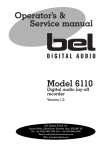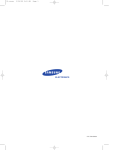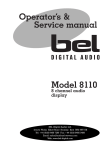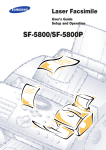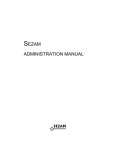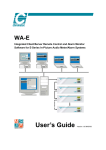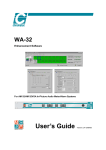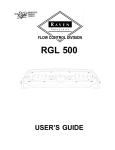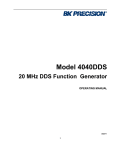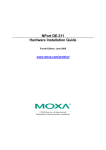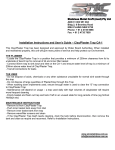Download 4a606bfa13b507210_manual.
Transcript
Operator’s & Service manual Model 7210 Delay synchroniser BEL (Digital Audio) Ltd. Invicta Works Elliott Road Bromley Kent BR2 9NT UK Tel: +44 (0)20 8460 7299 Fax: +44 (0)20 8460 0499 Email: [email protected] Web: www.bel-digital.com Contents INTRODUCTION 4 FEATURES 4 Delay 4 Soft track 4 Analog I/O 4 Analogue gain adjustment 4 Digital I/O 5 Memory 5 Keyboard lock 5 Time code delay 5 OPERATION AND FRONT PANEL KEYS 5 5 Mode 6 Program 6 Lock 6 Nudge up / down 6 > < Bypass LCD Display 7 SETUP DESCRIPTION 8 Video mode 8 Audio source 8 Increment mode 8 Increment value 8 AES Reference source 8 Gain track 8 Headroom 9 Output gain 9 Input gain 9 2 RS232 SERIAL CONTROL 10 CONNECTIONS 10 SPECIFICATION 11 FRONT VIEW OF UNIT - FIGURE 1 12 DETAIL OF SWITCHES ON FRONT - FIGURE 2 13 DEFAULT LCD - FIGURE 3 13 REAR PANEL VIEW - FIGURE 4 13 LCD DISPLAYING SETUP B - FIGURE 7 14 7210 BLOCK DIAGRAM 15 TROUBLE SHOOTING 16 SERVICE INFORMATION CONTENTS 17 3 BEL 7210 Delay synchroniser INTRODUCTION The BEL 7210 is a DSP based delay synchroniser that offers manual resynchronisation of audio and video signals. Fig 1. Analogue and digital AES/EBU input / output are provided together with an unobtrusive automatic delay tracking system. The unit was designed to resynchronise audio to video following processes such as standards conversion, video F/X, video synchronisation, satellite transmission etc. FEATURES DELAY The BEL 7210 can provide up to 1.3 Secs (30 frames) of stereo or 2.6 Secs (60 frames) of mono audio delay. This delay can be adjusted manually, by using the front panel controls. Three modes of operation are possible, stereo, mono and dual mono. Using the dual mono mode, the left and right channels of a stereo signal can be delayed by different amounts. In all modes the delay may be manually adjusted in sample, mSec, field or frame increments. The field and frame step values change to reflect the PAL or NSTC video mode selection. Bypass can be selected by means of a front panel control but it will also automatically engage in the event of a power failure. SOFT TRACK Any delay adjustments are carried out using a soft track algorithm. This allows delay changes to be achieved with the minimum of disturbance to the audio signal. Analogue I/O The BEL 7210 provides an 18/20 bit analogue stereo input-output system. The output provided by the unit is always analogue and digital. In this way the BEL 7210 can be used as an A/D or D/A converter. Two male XLR and two female XLR connectors are provided on the back panel. Fig 4. ANALOGUE GAIN ADJUSTMENT The analogue input and output gain of the BEL 7210 can be adjusted using the setup software. Two modes are possible: 1. Gain track. In this mode the software will adjust the input and output gain to give the required headroom and still maintain unity overall gain. 2. Independent input and output gain adjustment. 4 DIGITAL I/O The BEL 7210 provides a fully synchronised AES EBU compatible digital audio interface. A sample rate converter is used on the input allowing the conversion of 32kHz, 44.1kHz digital sources to 48kHz. A digital referencing system is employed which will synchronise the digital output to various type of input (AES, WORD, VIDEO and INTERNAL). The digital REF AES input can be used with sampling rates other than 48kHz but as the unit is optimised for 48kHz the displayed delay will then be in error. e.g. If 44.1kHz AES REF is used, a displayed delay setting of 10 mSec would actually be 10.88 mSec. When BYPASS is selected the digital signal input, if active, will be connected directly to the digital output socket. This situation also occurs if the power fails allowing a degree of fault tolerance. The digital output is always operating concurrently with the analogue output. The source, however, is either analogue or digital. Thus the BEL 7210 can be used as an analogue to digital or digital to analogue converter. It is recommended that an external reference is used. The unit will automatically sense whether PAL or NTSC is used as a video reference and produce a 48kHz AES digital output locked to this. Three XLR type connectors are provided on the rear panel for AES digital input, output and reference input. A further two BNC connectors are provided for video and word clock reference inputs. Fig 4. MEMORY Frequently used delay parameters can be stored in one of eight memories and retained when the unit is switched off. KEYBOARD LOCK Inadvertent operation of the keys can be avoided by invoking the key ÔlockÕ function. The unit will power-on with the keys in a locked state if the internal DIL switch SW 1 position one is on, refer to the lock section before attempting adjustments. Fig 5. TIME CODE DELAY A linear time code input and output are provided, these will allow time code to delayed to the same degree as the audio. Fig 4. In the independent right/ left mode the time code is delayed by the same amount as the right channel. 5 OPERATION AND FRONT PANEL KEYS Seven keys are located on the front panel, Fig 1 and Fig 2, these are:BYPASS This key connects the input directly to the output, bypassing the delay processor, using an electromechanical switch. The unit powers up in the delay mode: Press the key once to enter the bypass mode and again to return to the delay mode. A letter B is displayed on the LCD display when the unit is in the bypass mode. MODE Depressing this key will cause the unit to cycle through the operating modes in the sequence: stereo, right, left, mono. The delay setting in each mode is independent. e.g. The left or right delay can be adjusted without affecting the stereo or mono settings. PROGRAM This control will allow up to eight frequently used settings to be stored in a non volatile memory. Program numbers P0 to P7 are initially factory set to: P0 P1 P2 P3 P4 P5 P6 P7 Audio source dig ref. Increment Video mode Gaintrack Headroom - 0 mS 0 mS 0 mS 0 mS 0 mS 0 mS 0 mS 0 mS Analog internal 20 mS PAL on 8dBu To change these settings proceed as follows: Press PROG key until the required program number appears on the display. Any subsequent adjustment carried out will now be associated with that program number. To recover the factory presets restart the BEL 7210 and press any key while the ÔBEL 7210 Vx.xÕ message is displayed. 6 LOCK NUDGE UP / DOWN > < When the unit is locked all the front panel keys, except LOCK, are inoperative. To release the keys press and hold the LOCK key for a period in excess of three seconds. A momentary press of the LOCK key will again place the unit in the lock mode. The locked mode is indicated by an L on the LCD display. Pressing the up or down nudge keys will increase or decrease the manual delay setting. The amount the delay will change for each key press is defined in setup. If the key is held depressed the requested delay will steadily increase or decrease (run). The rate at which the delay changes can be increased by first pressing the nudge key in the required direction, holding it, and then simultaneously pressing the other nudge key. Delay changes are carried out using the soft track algorithm. LCD DISPLAY On power-up the LCD will show model number, software version and model description for a few seconds before resetting to the default display. Fig 3. In its default mode the LCD will display: An input level indicator. These bars will show the input level on an analogue or digital source with each vertical line in the bar representing 1dB. On the upper line of the LCD: 1. The current program number. (Pn) 2. The current mode. Stereo, Right, Left or Mono. 3. The manual delay requested. The units will reflect those selected in the setup. On the lower line: 1. The letter B is displayed while the unit is in bypass mode. 2. The letter L is displayed while the unit is in the locked mode. 3. The word DELAY. 4. The current actual delay. This will change to show the progress of the soft track mechanism. This display is always in milli Seconds. 7 SETUP DESCRIPTION The setup up options can be accessed by pressing the setup key. During the setup process a 10 second timer is running so that if a key is not pressed in that interval the 7210 will revert to normal operation. It is possible to quit the setup dialogue at any time by pressing a key other than nudge or setup. The setup key is used to sequence through the options and the nudge keys to adjust the values. VIDEO MODE This will select the current video mode (PAL or NTSC) and thus dictate the size of delay step for each field or frame nudge. AUDIO SOURCE The source of input audio ( analogue or digital ) can be selected here. INCREMENT MODE This allows the selection of Sample, milli second, field or frame steps in response to a delay nudge. INCREMENT VALUE This allows the actual value of the delay nudge step to be adjusted. It is continuously variable between 1 and 65000. AES REFERENCE SOURCE This page allows the reference source for the digital output to be selected. The possible sources are: INTERNAL Internal crystal source at 48k. samples/Sec. AES An external AES digital reference provides the source. VIDEO An external video signal provides the source. The unit will automatically sense PAL or NTSC and provide a 48kHz lock from this. WORD CLOCK An external 48kHz TTL word clock. GAIN TRACK This will allow the headroom or individual I/O gain modes to be selected. 8 HEADROOM This will only appear in the gain track mode and will facilitate the selection of the required headroom. The range is 0 to 18 dBu. Please ensure Gain Track is switched off before attempting to adjust output & input gain controls. OUTPUT GAIN This will only appear in the individual gain mode and allows the output analogue gain to be adjusted. The range of adjustment is -20 to + 10 dB. It is possible to adjust this gain and to carry out an internal adjustment to provide an output level of up to +22dB. INPUT GAIN This will only appear in the individual gain mode and allows the input analogue gain to be adjusted. The input level bar graph display is also visible. The range of adjustment is -20 to +10 dB. 9 RS232 SERIAL CONTROL The BEL 7210 can be externally/ remotely controlled via the 9 pin RS232 socket on the rear panel. Information regarding the serial protocols used together with a demonstration program for a PC are available. CONNECTIONS The rear panel of the BEL 7210 has 12 connectors, a mains switch and fuseholder (240/220V - 250mA, 110/120V - 500mA). From the left these are: Mains power AES/EBU Digital output AES/EBU Digital input AES/EBU Digital reference Video Reference Word clock reference RS232 serial Port SMPTE LTC I/O Left and right audio outputs Left and right audio inputs 240 VAC ( Internally adjustable to 120VAC.) IEC 3Pin. XLR 3 Pin male XLR 3 Pin female XLR 3 Pin female BNC (optional termination). BNC 9 Pin D female. 9 Pin D female, IN pins 8,9 OUT pins 7,6 3 Pin XLR male balanced Pin 2 hot. To unbalance connect pin 3 to pin 1 on the cable connector. 3 Pin XLR female balanced Pin 2 hot. To unbalance connect pin 3 to pin 1 on the cable connector. It is recommended that, where possible, all cables be good quality screened twisted pairs with the screening braid connected to pin 1 on the XLR connector. Optimum performance is obtained using double screened cable with separate ground returns. It is also recommended that 360 degree connection be made to the screening braid on the BNC connectors. EMC COMPLIANCE The BEL 7210 was designed and tested to comply with the EMC directive numbers EN55103, EN55022, EN55082-1 and EN60950 when used as directed. This unit must be used with an earthed mains lead to comply with the CE low voltage directive. CE 10 SPECIFICATION Delay Delay increments Video system Analogue I/O : Frequency response Input dynamic range Signal to noise ratio Distortion Conversion accuracy Sampling rate Inputs Outputs Digital I/O : Input Output Reference RS232 serial port Supply voltages Supply currents Fuse ratings (semi delay) 0 - 1.3 Secs stereo, 0 -2.6 Secs mono Samples, milli Secs, Fields, Frames PAL or NTSC 20 Hz - 20 kHz ± 1dB 106 dB -100dB. r.m.s. 20 -20 kHz less than 0.015% at 1 kHz A/D 18 bit Delta Sigma 64 x oversampled D/ A 20 bit 8 x oversampled 48 kHz. Internal reference Electronically balanced 25k W Electronically balanced 600 W Max. drive capability +18dBu ( Internally adjustable to +22dBu) AES/EBU 32 - 48kHz nominally 48 kHz 24 bits AES/EBU 48kHz. 24 bits 1. Internal crystal 2. External word clock. (48 kHz) 3. External AES/EBU. (48kHz) 4. External video. (PAL 1V pk - pk) 9.6 kbaud, 8 data bits 1 stop bit no parity. BEL 7210 serial protocol 110 - 120 Vac, 220 - 240 Vac 300mA @ 120 Vac, 150mA @ 240Vac 500mA @ 120 Vac, 250mA @ 240Vac 11 FRONT VIEW OF UNIT Figure 1 12 DETAIL OF SWITCHES ON FRONT Figure 2 DEFAULT LCD Figure 3 REAR PANEL VIEW Figure 4 13 LCD DISPLAYING SETUP B Figure 7 14 7210 BLOCK DIAGRAM 15 TROUBLE SHOOTING The BEL 7210 is designed and constructed to ensure a long and fault free life, but if a problem does occur the following guidelines are provided. This unit is constructed using 2 main printed circuit boards and 6 sub assemblies. The two main PCBs carry the processor/DSP circuits Fig 5 and the analogue/ digital input output systems Fig 6. Six smaller PCBs carry: 1. The keyboard interface. 2. The LCD interface. 3. A system power supply. 4. Three interface boards on the rear panel concerned with I/O protection and EMC suppression. All of these printed circuit boards are plugable for rapid replacement. For replacement of these PCBs see the servicing section. If the outline fault finding suggestions which follow are unsuccessful, contact your BEL distributor, or the main BEL distributor, who will advise you and arrange for the unit to be repaired or provide you with replacement PCBs. A suite of diagnostic software routines are available, please consult your BEL distributor. FAULT CAUSES ÔDeadÕ unit Power supply fault Only fan or Power supply LCD backlight fault Power on C-MOS RAM message, then corruption ACTION Check fuses in the IEC and supply connector, then check fuses and connectors on the power supply PCB. Check fuses on the power supply PCB Reset memory to factory preset values by pressing any key while the power on message is visible. unresponsive No audio Check an audio input is present. (deflection on bars on LCD). output Ensure the required input mode, digital or analogue, is selected. Check the input or output gain selections. Noisy digital Reference output source Distorted output Headroom Ensure that the required digital output reference is selected and connected to the unit. Ensure sufficient headroom is selected in setup B. 16 SERVICE INFORMATION - CONTENTS PRESET RESISTORS 18 CPU Printed Circuit Board 18 Adaref Printed Circuit Board 18 Preset Capacitor 18 Adaref Printed Circuit Board 18 SWI Settings - CPU Printed Circuit Board 18 ADJUSTMENT OF MAINS POWER OPERATING VOLTAGE 19 TO CHANGE FROM 120/110V TO 240/220V 20 TO REMOVE MAIN PRINTED CIRCUIT BOARDS 21 TO REMOVE POWER SUPPLY 22 PRINTED CIRCUIT BOARD POSITIONS & DRAWINGS 23 7000 SERIES CPU ISS.2 - FIGURE 5 26 7000 SERIES ADA REF ISSUE 2 - FIGURE 6 27 17 SET-UP INFORMATION - SERVICE PRESET RESISTORS CPU PRINTED CIRCUIT BOARD 1) 2) RV1 - Liquid Crystal Display Contrast - Set for maximum readability RV2 - LTC (SMPTE) Output level - nominally set for 3v Pk/Pk (differential) ADAREF PRINTED CIRCUIT BOARD (INPUT/OUTPUT GAIN SET) With +8dB measured at the input XLR connectors (single ended) 1) Set RV1 and RV2 for -1dB @ TP3 and TP4 (RV1/TP3 = Right, RV2/TP4 = Left) With level track ÔoffÕ and 0dB input and output gain set:2) Set RV5 and RV6 for +4dB @ TP7 and TP8 (RV5/TP7 = Left, RV6/TP8 = Right) With 600 Ohm loads on output XLR Connectors (single ended): 3) Re-adjust RV5 and RV6 for +8dB measured across 600 Ohm loads. ADAREF PRINTED CIRCUIT BOARD Pre-set capacitor C138 adjustment (video PLL Lock range). With digital reference set to ÔVideoÕ and any external (AES Digital) Video reference disconnected, monitor the AES digital output for ÔSample FrequencyÕ adjust frequency to be within ± 25 ppm of 48kHz (Fs) Connect a suitable external (AES Digital) Video reference and check that ÔLockÕ is achieved. SWI SETTINGS CPU PRINTED CIRCUIT BOARD ON OFF 1 Keyboard un-locked on power-up Locked on power-up 2 Future Use Future Use 3 Future Use Future Use 4 TTL Pulse Neg. Going (7310 only) TTL Pulse Pos. Going (7310 only) 18 ADJUSTMENT OF MAINS POWER OPERATING VOLTAGE Adjustment is only required when changing from 240/220V to 120/110V. The unit is designed to operate correctly with voltages between 220-240V and 110-120V when set. To change from 240/220V to 120/110V proceed as follows:1) Remove mains power cable lead from the unit 2) Remove cover screws (19) and cover 3) Remove screws (9) associated with rear panel (2 at each end and 5 on underside) 4) Gently ease the rear panel away from the main printed circuit boards, disconnecting 3 header plugs (leave the fan cable connected). 5) The rear panel can now be tipped up so that the IEC inlet power connections are accessible. 6) Locate the 2 extra wires (orange & black) that are joined and tied back in the mains sleeving behind the IEC inlet. 7) Separate these 2 wires and re-connect as follows:- 8) Re-assemble in reverse order taking care to locate the 3 header plugs carefully i n their respective sockets before pushing firmly fully in. Also take care not to trap the fan power cable between the rear panel and chassis. 9) Remove mains fuse in IEC inlet and replace with 500ma semi-delay type. 10) Test unit applying mains power 110/120V. 19 TO CHANGE FROM 120/110V TO 240/220V PROCEED AS FOLLOWS:1) Carry out 1 - 5 as in the 240/220V - 120/110V change. 2) Disconnect the orange and black wires from the IEC inlet. 3) Join the orange and black together, sleeve/insulate and the back inside main power sleeving. 4) Connections should not be as follows:- 5) Re-assemble in reverse order taking care to locate the 3 header plugs carefully i n their respective sockets before pushing firmly fully in. Also take care not to trap the fan power cable between the rear panel and chassis. 6) Remove mains fuse in IEC inlet and replace with 250ma semi delay type. 7) Test unit applying 240/220V mains power. 20 TO REMOVE MAIN PRINTED CIRCUIT BOARDS (CPU AND ADAREF) Proceed as follows:1) Remove cover screws (19) and cover 2) Remove rear panel screws (9). 2 on each end and 5 on underside. 3) Remove the 3 centre plate/heatsink screws from the underside. 4) Gently ease the rear panel away from the main printed circuit boards, disconnecting the 3 header plugs. 5) Remove all ÔCPUÕ and ÔADAREFÕ printed circuit fixing screws (10). 6) Remove the 2 power supply connectors PL1 and PL3 and CPU keyboard and LCD connectors PL3 and PL4 7) Lift out of the chassis - ADAREF + CPU + centre plate. 8) To separate the ÔADAREFÕ and ÔCPUÕ printed circuit boards - cut the cable tie holding the ADAREF power cable on the underside of the ÔCPUÕ printed circuit board and pull ADAREF board away from CPU board disconnecting PLI/SKI and PL2/SK2. 9) To re-assemble follow the above in reverse order firstly pushing the CPU and ADAREF boards together and fitting a cable tie holding the ADAREF power cable in position. NOTE: Care should be taken not to trap the ADAREF power cable under the centre plate when re-fitting to chassis. (Locate in cutout provided in centre plate). * After board changes it may be necessary to reset the CPU Board to obtain correct operation (this will reset parameters to factory set values). Power-on and while the ÒlogonÓ information is displayed, i.e. Model No etc. Press the set key. The unit will then prompt for a reset. Pressing the set key again will reset. 21 TO REMOVE POWER SUPPLY The power supply can be removed with all other boards in place, proceed as follows:1) Remove power supply fixing screws (4) 3 on the chassis side and 1 on the underside of chassis (see drawing). 2) off). Disconnect all connectors from the power supply printed circuit board. PL1-PL5 (5 3) Tilt power supply towards the chassis side and lift out. 4) Re-assemble in reverse order making sure the spacer under the power supply chassis heat sink is properly located. (see drawing) 22






















